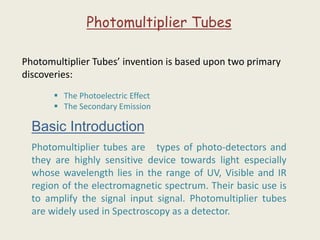Photomultiplier tubes
•Download as PPTX, PDF•
5 likes•8,207 views
These slides are about Photomultiplier tubes.
Report
Share
Report
Share

Recommended
Recommended
More Related Content
What's hot
What's hot (20)
Basics of Infrared Spectroscopy : Theory, principles and applications

Basics of Infrared Spectroscopy : Theory, principles and applications
UV spectroscopy, Electronic transitions, law of UV, Deviations of UV, chromop...

UV spectroscopy, Electronic transitions, law of UV, Deviations of UV, chromop...
FT-IR spectroscopy Instrumentation and Application, By- Anubhav singh, M.pharm

FT-IR spectroscopy Instrumentation and Application, By- Anubhav singh, M.pharm
Ultra violet (UV) spectroscopy, introduction,principle instrumentation,differ...

Ultra violet (UV) spectroscopy, introduction,principle instrumentation,differ...
Similar to Photomultiplier tubes
Similar to Photomultiplier tubes (20)
Chapter-3 - Photoelectricity, X-rays & Lasers (1).pdf

Chapter-3 - Photoelectricity, X-rays & Lasers (1).pdf
09 UNIT-9(Electronics and down of Modern Physics) (1).pptx

09 UNIT-9(Electronics and down of Modern Physics) (1).pptx
Recently uploaded
https://app.box.com/s/7hlvjxjalkrik7fb082xx3jk7xd7liz3TỔNG ÔN TẬP THI VÀO LỚP 10 MÔN TIẾNG ANH NĂM HỌC 2023 - 2024 CÓ ĐÁP ÁN (NGỮ Â...

TỔNG ÔN TẬP THI VÀO LỚP 10 MÔN TIẾNG ANH NĂM HỌC 2023 - 2024 CÓ ĐÁP ÁN (NGỮ Â...Nguyen Thanh Tu Collection
https://app.box.com/s/x7vf0j7xaxl2hlczxm3ny497y4yto33i80 ĐỀ THI THỬ TUYỂN SINH TIẾNG ANH VÀO 10 SỞ GD – ĐT THÀNH PHỐ HỒ CHÍ MINH NĂ...

80 ĐỀ THI THỬ TUYỂN SINH TIẾNG ANH VÀO 10 SỞ GD – ĐT THÀNH PHỐ HỒ CHÍ MINH NĂ...Nguyen Thanh Tu Collection
Recently uploaded (20)
TỔNG ÔN TẬP THI VÀO LỚP 10 MÔN TIẾNG ANH NĂM HỌC 2023 - 2024 CÓ ĐÁP ÁN (NGỮ Â...

TỔNG ÔN TẬP THI VÀO LỚP 10 MÔN TIẾNG ANH NĂM HỌC 2023 - 2024 CÓ ĐÁP ÁN (NGỮ Â...
80 ĐỀ THI THỬ TUYỂN SINH TIẾNG ANH VÀO 10 SỞ GD – ĐT THÀNH PHỐ HỒ CHÍ MINH NĂ...

80 ĐỀ THI THỬ TUYỂN SINH TIẾNG ANH VÀO 10 SỞ GD – ĐT THÀNH PHỐ HỒ CHÍ MINH NĂ...
This PowerPoint helps students to consider the concept of infinity.

This PowerPoint helps students to consider the concept of infinity.
On National Teacher Day, meet the 2024-25 Kenan Fellows

On National Teacher Day, meet the 2024-25 Kenan Fellows
ICT role in 21st century education and it's challenges.

ICT role in 21st century education and it's challenges.
Micro-Scholarship, What it is, How can it help me.pdf

Micro-Scholarship, What it is, How can it help me.pdf
Kodo Millet PPT made by Ghanshyam bairwa college of Agriculture kumher bhara...

Kodo Millet PPT made by Ghanshyam bairwa college of Agriculture kumher bhara...
Interdisciplinary_Insights_Data_Collection_Methods.pptx

Interdisciplinary_Insights_Data_Collection_Methods.pptx
Food safety_Challenges food safety laboratories_.pdf

Food safety_Challenges food safety laboratories_.pdf
Python Notes for mca i year students osmania university.docx

Python Notes for mca i year students osmania university.docx
Beyond_Borders_Understanding_Anime_and_Manga_Fandom_A_Comprehensive_Audience_...

Beyond_Borders_Understanding_Anime_and_Manga_Fandom_A_Comprehensive_Audience_...
General Principles of Intellectual Property: Concepts of Intellectual Proper...

General Principles of Intellectual Property: Concepts of Intellectual Proper...
Photomultiplier tubes
- 1. Photomultiplier Tubes Photomultiplier Tubes’ invention is based upon two primary discoveries: The Photoelectric Effect The Secondary Emission Basic Introduction Photomultiplier tubes are types of photo-detectors and they are highly sensitive device towards light especially whose wavelength lies in the range of UV, Visible and IR region of the electromagnetic spectrum. Their basic use is to amplify the signal input signal. Photomultiplier tubes are widely used in Spectroscopy as a detector.
- 2. Construction and Working The photomultiplier tubes are just similar in construction to phototubes. A phototube consists of a semi- cylindrical photocathode and an anode wire fixed inside an evacuated glass tube. When a voltage is applied across the two electrodes and when light electromagnetic waves falls on the photocathode, the emission of electrons takes place and these electrons tend to move towards anode and hence the photocurrent is observed. Photomultiplier tubes are similar to that of phototube that gives electrical signal on exposure of electromagnetic waves.
- 3. The electrons emitted from photocathode start drifting towards anode (dynode) which is maintained at up to 100 volt more positive with respect to cathode. Primary Electrons The electrons emitted after the strike of photons to photocathodes are called ‘primary electrons’. Secondary Electrons The electrons ejected from dynode D1 by the fall of primary electrons on it are called ‘secondary electrons’ and similarly when these electrons fall on the surface of dynode D2, more electrodes are emitted than earlier. These are all called secondary electrons.
- 4. In this way by the successive striking of electrons on dynodes surface yield a large number of electrons which are easily detectable as represented by the output current. Look at the diagram below:
- 5. Note that in the above diagram, dynode D1 is ~100 volt more positive with respect to photocathode, D2 is 100 volt more positive than D1, D3 is at 100 volt more positive than D2 and so on. In this way amplification of electrons which is our gain takes place we can imagine this multiplication process by an estimation that each Photon results in the emission of about 107 electrons. Muhammad Hamza Tahir mhamzatahir481@gmail.com +923126958957